Numerical and Analytical Simulations of Nonlinear Time Fractional Advection and Burger’s Equations
Abstract
In this paper, the higher nonlinear problems of fractional advection-diffusion equations and systems of nonlinear fractional Burger’s equations are solved by using two sophisticated procedures, namely, the q-homotopy analysis transform method and the residual power series method. The proposed methods are implemented with the Caputo operator. The present techniques are utilised in a very comprehensive and effective manner to obtain the solutions to the suggested fractional-order problems. The nonlinearity of the problem was controlled tactfully. The numerical results of a few examples are calculated and analyzed. The tables and graphs are constructed to understand the higher accuracy and applicability of the current method. The obtained results that are in good contact with the actual dynamics of the given problem, which is verified by the graphs and tables. The present techniques require fewer calculations and are associated with a higher degree of accuracy, and therefore can be extended to solve other high nonlinear fractional problems.
1. Introduction
The most powerful tool for researchers to simulate various physical phenomena in applied sciences and nature is known as fractional partial differential equations (FPDEs). The following physical phenomena have been accurately modelled by FPDEs: optics [1], economics [2], fluid traffic [3], electrodynamics [4], hepatitis B virus [5], tuberculosis [6], air foil [7], modelling of earth quack nonlinear oscillation [8], propagation of spherical waves [9], Chaos theory [10], fractional COVID-19 model [11], finance [12], pine wilt disease [13], Zener [14], cancer chemotherapy [15], traffic flow model [16], Poisson-Nernst-Planck diffusion [17], diabetes [18], biomedical and biological [19], and many other numerous applications in various branches of applied mathematics (see [20–22]). Due to these numerous applications, FPDEs and factional calculus have gained more attention from researchers as compared to ordinary calculus.
To obtain the approximate solutions to the above models, researchers use and develop a variety of analytical approaches. The frequently used methods are optimal homotopy asymptotic method (OHAM) [23], Iterative Laplace transform method [24], extended direct algebraic method (EDAM) [25], Adomian decomposition method (ADM) [26], the Finite difference method (FDM) [27], the homotopy perturbation transform technique along with transformation (HPTM) [28], the (G/G′)-expansion method [29], the Haar wavelet method (HWM) [30], standard reductive perturbation method [31], the variational iteration procedure with transformation (VITM) [32], and the differential transform method (DTM) [33]. In this context, Hassan et al. have presented the solutions of some nonlinear FPDEs which can be seen in [34–36]. Some useful methods can be seen in [37–39].
Obtaining the analytical solutions of FPDEs and their systems has been a difficult task for researchers in recent years. In this circumstance, Prakash and Kaur use q-HATM [40] to solve the time-fractional Navier Stokes equation. Similarly, q-HATM was implemented by Kumar et al. and used to obtain the solutions of the fractional long-wave equations in the regularised form [41]. The Schrodinger generalized form of fractional order was solved by Veeresha et al. using q-HATM [42]. The q-HATM convergence was done by El-Tawil and Huseen [43]. The RPSM technique was used by Alquran to solve the drainage equation in [44] and the fractional-order Phi-4 equation in [45]. The Whitham-Broer-Kaup equation of fractional order was analysed by Wang and Chen by using RPSM [46]. RPSM has been used in [47] to find the solution of the fractional Biswas-Milovic equation of multidimensions. Komashynska et al. used the RPSM [48] to solve a system of multipantograph delay differential equations. In [49], RPSM was used to find an approximation solution for the fractional-order Sharma-Tasso-Olever equation. The solutions to the fractional order Schrodinger equations were determined using RPSM in [50]. The RPSM has been used to solve a variety of problems, including the gas dynamic equation [51], the Emden-Fowler equation, Berger-Fisher equation, and the Benney-Lin equation in its fractional format, solved by RPSM in [52]. Similarly, RPSM was used by Al-Smadi [53] to overcome the solutions to initial value problems.
In this paper, the solutions of systems of fractional Berger’s equations and nonlinear advection equations were examined by combining two analytical techniques, q-HAM and RPSM. The results are compared to each other as well as the exact solution to the given problems. The current methods are used to compare the solutions methodologies for the analysis of the higher nonlinear problems of fractional advection-diffusion equations and systems of nonlinear fractional Burger’s equations in the Caputo sense. The obtained approximate series solutions are fast converging towards the exact solutions of the targeted problems, according to quantitative analysis. It is found that the techniques under discussion are simple and effective for the solutions of FPDE systems. The graphs and tables for the solutions to the targeted problems via RPSM and q-HATM. It is confirmed that the obtained solutions are in good contact with the exact solution to the problems. The fractional order solutions are convergent towards the integer order solutions, which shows the reliability of the fractional solutions. The presented techniques have a wide range of applications and could be used to examine approximate analytical solutions of other nonlinear FPDEs and multidimensional systems of FPDEs in the future.
This paper will be formatted as follows: in the second section, some basic definitions are discussed. In Section 3, the methodology is described, and in Section 4, two separate techniques are used to compare certain numerical results. The conclusion and references are found in the fifth and final section of the paper.
2. Basic Definitions
In this section we will discuss some important definitions
2.1. Definition
2.2. Definition
2.3. Laplace Transform (LT)
2.4. Definition
2.5. Definition
2.6. Definition
2.7. Theorem
Proof. See [43]
2.8. Theorem
suppose that u(t) ∈ C[t0, t0 + R] and fork = 0, 1, 2, ⋯, n + 1,
Proof. See [58].
2.9. Theorem
Proof. See [58].
2.10. Theorem
Proof. See [58].
3. RPSM and Q-HATM Procedures
3.1. RPSM Procedure for FPDEs System [60]
As in [61, 62], it is clear that Res(x, y, z, t) = 0 and . Therefore, , , and . In the Caputo definition, the constant has zero derivative therefore , k = 0, 1, ⋯, n which mean that of Resυ(x, y, z, t), Resϑ(x, y, z, t), Resϖ(x, y, z, t), and Resk(x, y, z, t) are t = 0 matching at n = 0, 1, ⋯, k; .
3.2. Q-HATM Procedure for FPDEs System [63]
Eq. (33) and Eq. (35) are known q-HATM series solutions for the given system.
4. Numerical Results
4.1. Example
4.1.1. RPSM-Solution
4.1.2. Q-HATM Solution
4.2. Example
4.2.1. RPSM-Solution
4.2.2. Q-HATM Solution
5. Results and Discussion
Here, we will discuss the numerical solutions. In Figure 1, 3D plots of (a) RPSM, (b) Exact, and (c) q-HATM ψ−solutions at δ = 1 of Example 4.1 are presented. Which are in closed contact with the exact solution of Example 4.1. In Figure 2, 2D plots of (a) RPSM, (b) Exact, and (c) q-HATM ψ−solutions at δ = 1 of Example 4.1 are presented, from which the validity of the proposed methods are confirmed. While in Figure 3, 3D plots of Example 4.1 for fractional order δ = 1,0.9 are plotted. Numerical values of Example 4.1 are presented in Table 1. In Figure 4, 2D-solutions plots and Figure 5 of (a) RPSM, (b) Exact, and (c) q-HATM, at δ = 1 of Example 4.2 are plotted. The RPSM and q-HATM solutions are very closed to the exact solution. The RPSM and q-HATM solutions graphs at different fractional order are plotted in Figure 6.
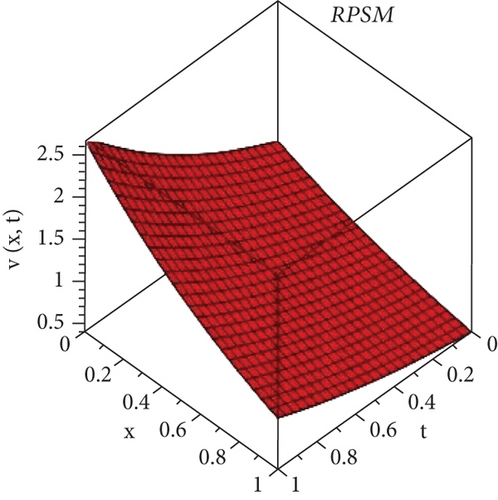
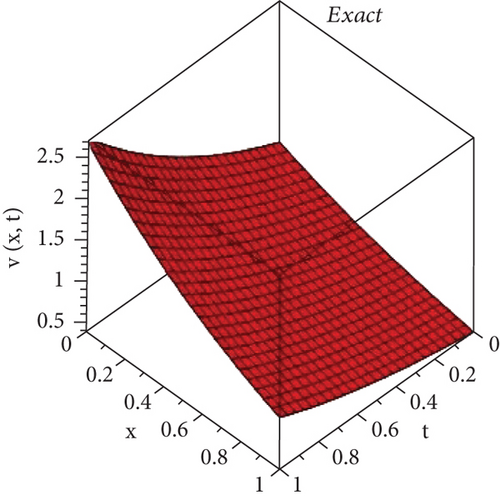
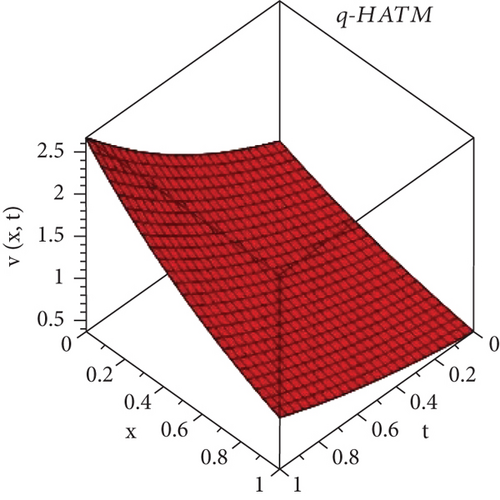

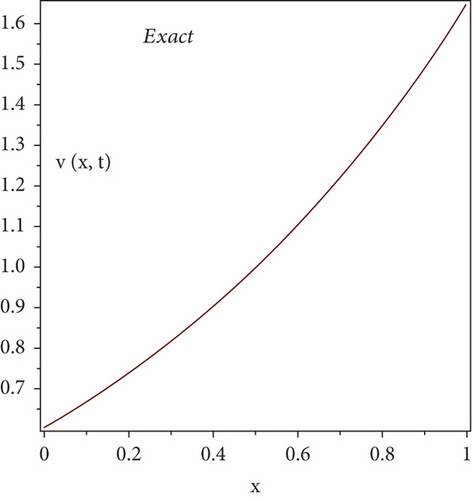
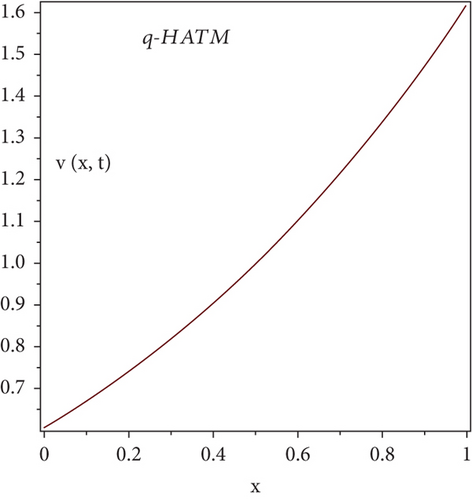
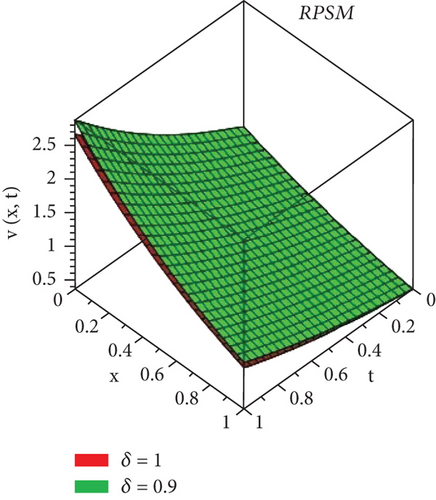
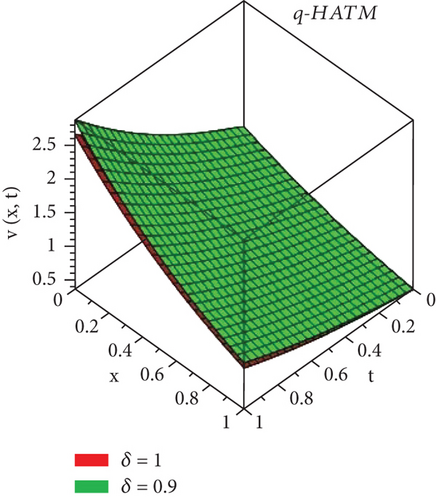
| x | t | RPSM | RPSM | q-HATM | q-HATM | Exact |
|---|---|---|---|---|---|---|
| δ = 0.9 | δ = 1 | δ = 0.9 | δ = 1 | δ = 1 | ||
| 0.25 | 0.001 | 0.7804183 | 0.7795799 | 0.7804183 | 0.7795799 | 0.7795799 |
| 0.50 | 0.6077903 | 0.6071374 | 0.6077903 | 0.6071374 | 0.6071374 | |
| 0.75 | 0.4733476 | 0.4728391 | 0.4733476 | 0.4728391 | 0.4728391 | |
| 1 | 0.3686435 | 0.3682475 | 0.3686435 | 0.3682475 | 0.3682475 | |
| 0.25 | 0.005 | 0.7857118 | 0.7827045 | 0.7857118 | 0.7827045 | 0.7827045 |
| 0.50 | 0.6119130 | 0.6095709 | 0.6119130 | 0.6095709 | 0.6095709 | |
| 0.75 | 0.4765583 | 0.4747342 | 0.4765583 | 0.4747342 | 0.4747342 | |
| 1 | 0.3711440 | 0.3697234 | 0.3711440 | 0.3697234 | 0.3697234 |
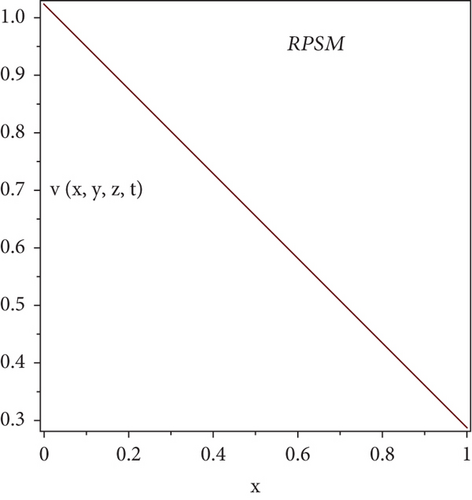
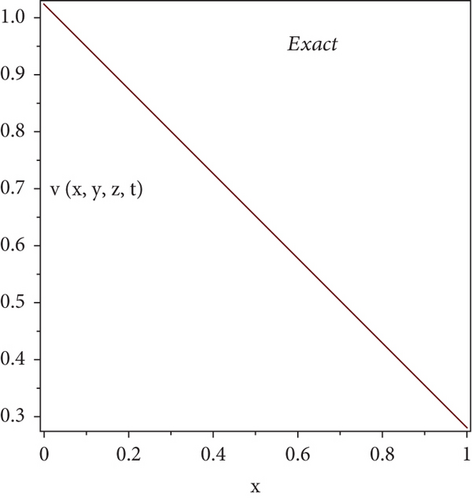

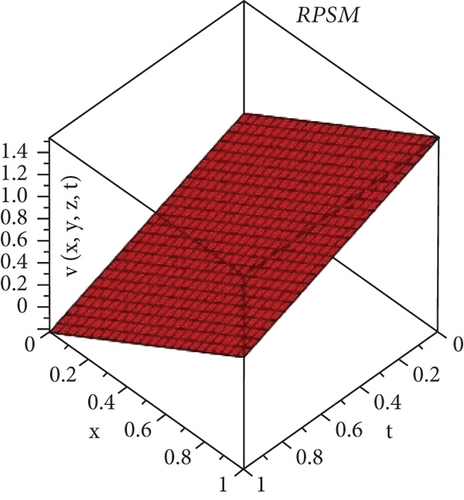
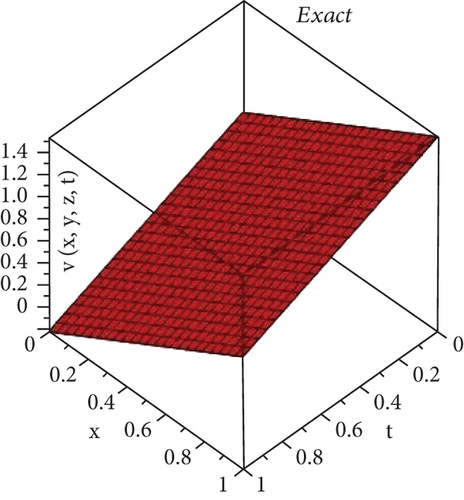
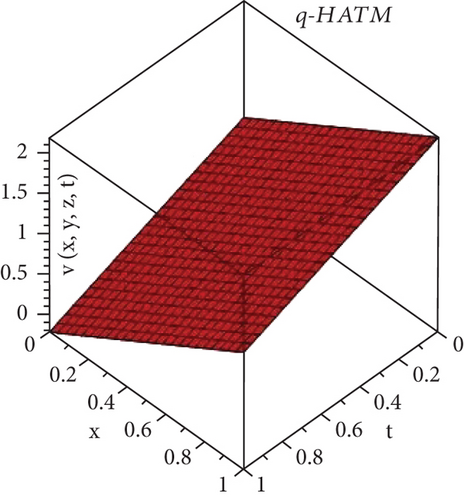
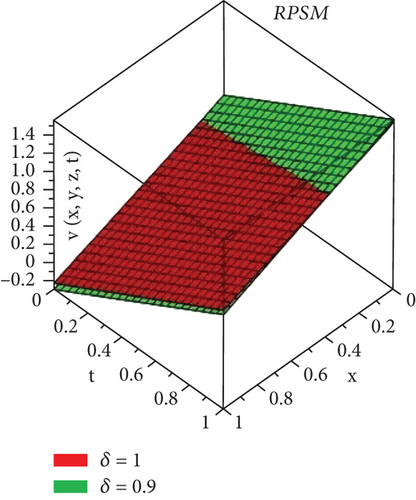
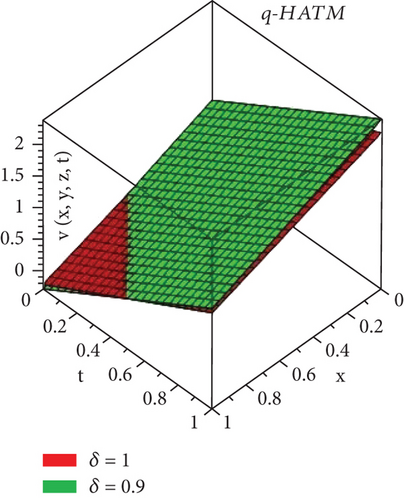
6. Conclusion
In this paper, the solutions of nonlinear systems of fractional Burger’s equations and advection diffusion equation are calculated by using q-HATM and RPSM. The proposed methods provide the results with higher degree of accuracy and using very few terms of their series solutions. The solutions comparison of both techniques are compared with the actual solutions of each problem. The comparison has shown the best compromise between the solutions of the suggested techniques. The fractional-order solutions are calculated successfully and shown to be convergent towards the integer-order solutions. The novelty of this paper is given in the nonlinear fractional solutions which provide the more accurate results as compared to other studies in literature. In the future, the suggested techniques can be utilised easily for the solutions of higher dimensional and nonlinear FPDEs and their systems because of their simple and straightforward implementation.
Disclosure
This work is performed as part of the employment of the authors.
Conflicts of Interest
No competing interests are declared.
Authors’ Contributions
Hassan Khan was responsible for supervision, Qasim khan was responsible for methodology and draft writing, Fairouz Tchier was the project administrator, Ibrar Ullah was responsible for the methodology, Evren Hincal was responsible for funding and draft writing, Gurpreet Singh was responsible for draft writing, F. M. O. Tawfiq was responsible for the investigation, and Shahbaz Khan was responsible for the methodology and draft writing.
Acknowledgments
Researchers Supporting Project (no. RSP-2021/401), King Saud University, Riyadh, Saudi Arabia.
Open Research
Data Availability
No data were used to support this study.




